Creating the perfect ambiance in your living room isn’t just about the right furniture or decor; it’s about how you illuminate the space. Mood lighting, with its transformative power, can turn your living room into a cozy retreat, a vibrant entertainment hub, or a sophisticated haven. Whether you’re looking to unwind after a long day or impress your guests, understanding the versatility of mood lighting puts you in control of your living space.
To help you achieve the perfect lighting, this blog post from Helio Archi lets you know all the lighting ideas you need. From ambient lighting to accent and task lighting, we’ll guide you through the different types of lighting and how they can be used to create the desired mood in your living space. Discover how to place lights strategically, choose the right fixtures, and utilize dimmers to control the intensity and color of light. With these tips and ideas, your living room can become a versatile and inviting space that reflects your style and meets your needs for any occasion.
Why is Mood Lighting for Living Room Important?
Lighting is a powerful tool in interior design. It not only sets the tone but also significantly enhances the overall atmosphere of your living space. The proper lighting can make a room feel larger, warmer, and more inviting. It can highlight architectural features, create focal points, and add a layer of sophistication to your decor. In essence, mood lighting is essential in creating a comfortable and aesthetically pleasing living room. Be with us to learn more mood lighting ideas that can revolutionize your living room into a cozy, stylish haven.
Types of Living Room Mood Lighting Ideas
Mood lighting isn’t a one-size-fits-all solution. Different types of lighting serve different purposes and can be combined to create a balanced and harmonious environment. Here are some types:
Enhancing Your Living Room with Ambient Lighting
Ambient lighting provides general illumination for the entire room, creating a comfortable and inviting atmosphere. The foundational layer of lighting sets the overall mood and tone of the space. Typically, ambient lighting comes from ceiling lights such as chandeliers, pendant lights, or recessed lighting. These fixtures are designed to distribute light evenly across the room, ensuring no shadows or dark corners.
Additionally, dimmer switches can enhance ambient lighting, allowing you to adjust the brightness to suit different occasions or times of day. Choosing the right fixtures and bulbs is crucial for achieving a balanced and harmonious lighting scheme that complements the room’s design and functionality.

Living Room Task Lighting Ideas
Task lighting is focused lighting intended for specific activities such as reading, working, or dining. This type of lighting is not just a luxury, but a necessity for areas where detailed work or close-up tasks are performed. Examples include table lamps, desk lamps, and under-cabinet lighting, which provide targeted illumination directly where it is needed most.
Task lighting should be bright enough to reduce eye strain, ensuring that the eyes do not need to work too hard to see clearly, but not so intense that it creates glare, which can be equally straining. Proper task lighting can enhance productivity and comfort, making it a crucial element in residential and professional environments.
Accent Lighting: One of the Best Mood Lighting Ideas for a Living Room
Accent lighting highlights architectural features, artwork, or decorative elements in your living room. It adds depth and dimension to the space by drawing attention to focal points, creating visual interest. Wall sconces, picture lights, and track lighting are popular choices for accent lighting, each offering a unique way to enhance your room. For example, wall sconces can warmlycreate a warm glow on textured walls, while picture lights can illuminate your favorite art pieces, making them stand out. On the other hand, track lighting offers flexibility and can be directed to highlight various elements.
The key is to use accent lighting sparingly to create a sense of drama and interest without overwhelming the room. Properly placed, it can transform your living space into a more inviting and aesthetically pleasing environment.
Decorative Lighting for Living Room Ambiance
Decorative lighting serves an aesthetic purpose, adding artistic elements to your living room and creating a warm, inviting atmosphere. These fixtures are often statement pieces that double as functional art, drawing the eye and sparking conversation. Examples include elegant chandeliers that cast a soft, ambient glow, designer floor lamps that offer both style and practicality and unique light sculptures that add a touch of modern sophistication.
Decorative lighting can enhance your decor theme, create a cohesive look, and reflect your style, making your living space your own. Integrating the proper lighting can transform a room, making it feel more spacious, cozy, or vibrant, depending on your needs.
Lighting Fixtures Ideas for Living Room
Choosing the right fixtures is just as important as selecting the type of lighting. The fixtures you choose can significantly impact the ambiance and functionality of a space. Here are some popular options to consider:
Ceiling Lights
Ceiling lights are a staple in any living room, providing the primary source of ambient lighting that sets the tone for the entire space. Chandeliers, with their intricate designs and multiple light sources, offer a touch of elegance and are perfect for traditional or formal settings. They create a focal point that draws the eye upward.
Pendant lights, available in various styles and finishes, are versatile and can be used in multiple room styles, from industrial to modern to rustic. Recessed lighting, often installed in a grid pattern across the ceiling, offers a clean, contemporary look and can be strategically placed to highlight specific areas or features of the room.
These different types of ceiling lights can be combined to create a well-lit and inviting living room that suits any taste or decor.
Wall Lights
Wall lights are excellent for accent and task lighting, offering functional and aesthetic benefits. Sconces can be strategically placed on either side of a fireplace, mirror, or artwork to create a sense of balance and add a soft, welcoming glow to the room. Picture lights are designed to illuminate artwork, enhancing its colors and highlighting fine details that might go unnoticed.
Wall-mounted fixtures can also serve as convenient reading lights beside a sofa or armchair, providing focused lighting that doesn’t take up floor or table space. Additionally, the versatility of wall lights makes them suitable for hallways, bedrooms, and bathrooms, where they can contribute to the overall ambiance and practicality of the space.
Floor and Table Lamps
Floor and table lamps are versatile lighting options that can be easily moved around to suit your needs. They provide additional ambient and task lighting, which can enhance the atmosphere of any room. For example, a tall floor lamp can brighten up a dark corner, making the space feel more open and inviting.
Alternatively, place a small table lamp on a side table to create a cozy reading nook perfect for unwinding with a good book at the end of the day. These lamps’ flexibility allows you to adjust your lighting setup as needed, giving you the ability to change the ambiance of a room with ease.
Whether hosting a gathering or enjoying a quiet evening alone, the proper lighting can make all the difference.
LED Strips and Smart Lighting
Consider LED strips and smart lighting solutions for a modern and customizable approach. LED strips can be placed under shelves, around the perimeter of the ceiling, or behind furniture to create a subtle glow, enhancing the ambiance of any room. These strips come in various lengths and colors, allowing you to tailor the lighting to your needs and decor.
Smart lighting systems, like Philips Hue, offer even more flexibility. They allow you to control the color, brightness, and on/off schedule via a smartphone app or voice commands, offering unparalleled convenience and personalization. With these systems, you can set the mood for any occasion, whether a cozy movie night, a vibrant party, or a focused work session. Additionally, many smart lighting solutions are compatible with other smart home devices, enabling seamless integration into your existing setup.
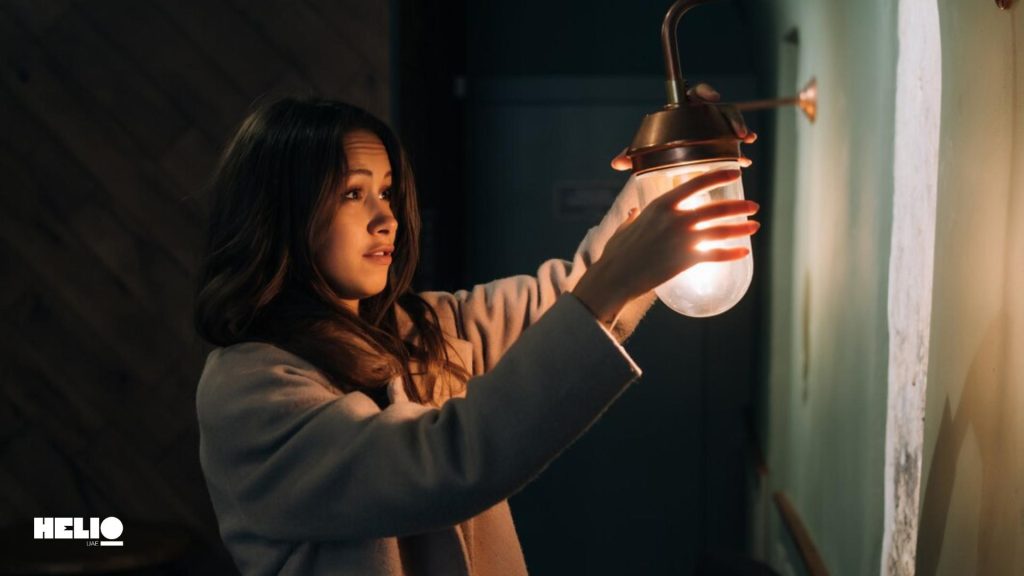
Creating Ambiance with Mood Lighting Ideas for Your Living Room
The ambiance of your living room can be significantly influenced by the type of lighting you choose. Soft, warm lighting can create a cozy and inviting atmosphere, while brighter, cooler lighting can make the space more open and energetic. Additionally, the placement and style of light fixtures play a crucial role in enhancing the overall decor and functionality of the room.
Warm vs. Cool Lighting
The color temperature of your lighting plays a crucial role in setting the mood and functionality of a space. Warm lighting, typically from 2700K to 3000K, creates a cozy and inviting atmosphere perfect for relaxation, socializing, and a welcoming ambiance. This type of lighting is often used in living rooms, bedrooms, and dining areas to promote a sense of comfort and warmth.
On the other hand, cool lighting, which falls between 3500K and 4100K, is more energizing and works well for task-oriented areas. This lighting is ideal for kitchens, offices, and bathrooms where clarity and focus are essential. Cool lighting helps to keep you alert and productive, making it easier to complete tasks that require attention to detail.
It’s essential to strike a balance that matches the function and feel of your room. By carefully considering the color temperature of your lighting, you can enhance the overall ambiance and functionality of each space in your home, ensuring that it meets both your aesthetic and practical needs.
Dimmers and Controls
Installing dimmers and smart controls allows you to adjust the light levels to suit different occasions, providing versatility and ambiance in your home. For example, you can dim the lights for a cozy movie night, create a perfect cinema-like experience in your living room, or brighten them for a lively gathering with friends and family to ensure every detail is highlighted.
Smart lighting systems offer the added benefit of pre-set modes, enabling you to easily switch between different lighting scenarios. Imagine having a setting for a romantic dinner or reading and yet another for a vibrant party, all at the touch of a button.
These systems enhance your living spaces and contribute to energy savings and convenience.
Layering Lighting
Combining various types of lighting—ambient, task, accent, and decorative—creates layers that add depth and texture to your living room. Ambient lighting provides overall illumination, setting the tone of the room. Task lighting focuses on areas where activities like reading or cooking occur. Accent lighting highlights architectural features or artwork, adding a touch of elegance. Decorative lighting, such as chandeliers or stylish table lamps, enhances the room’s aesthetic appeal.
Layered lighting ensures that every part of the room is adequately lit and enhances the overall aesthetic. Experiment with combinations and fixtures to find the perfect balance for your space, ensuring functionality and beauty.
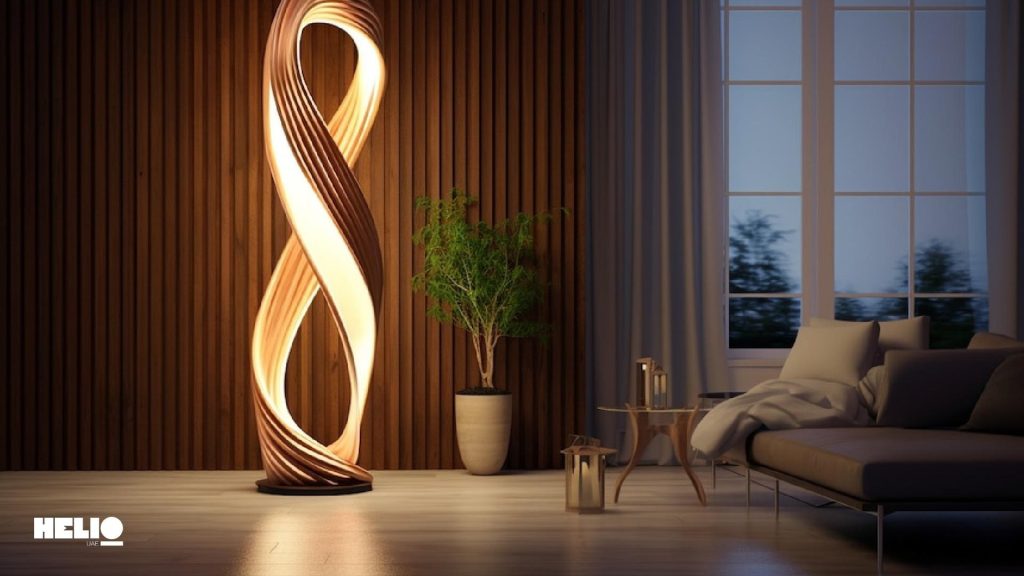
Highlighting Architectural Features
Strategic lighting can enhance architectural features to create stunning visual effects, making spaces appear more inviting and highlighting key design elements. Thoughtfully placed lighting can transform ordinary structures into extraordinary visual experiences, adding depth, dimension, and ambiance to any environment.
Using Uplights and Downlights
Uplights and downlights highlight structural elements such as columns, arches, and textured walls. Uplights direct light upwards, creating a dramatic effect by illuminating the architecture from below, which can enhance the perceived height and add a sense of grandeur. On the other hand, downlights cast a focused beam downwards, emphasizing specific areas and details providing a more subtle and controlled illumination.
This combination can create a balanced and visually appealing lighting design that showcases and complements the structure’s architectural features.
Backlighting
Backlighting involves placing light sources behind objects or surfaces to create a glowing effect. This technique is often used for TV units, shelves, and wall panels, providing a subtle yet striking illumination.
Backlighting can highlight architectural features, emphasize textures, and set a mood within a space by casting a soft, diffused light. Beyond its aesthetic appeal, backlighting also serves practical purposes, such as reducing eye strain when watching TV in the dark.
Overall, backlighting adds a modern and sophisticated touch to your living room, transforming it into a more inviting and visually captivating environment.
Spotlighting Artwork
Art lovers can use spotlights to draw attention to their favorite pieces, creating a focal point in the room. Position the spotlight at an angle to avoid glare and highlight the artwork’s colors and intricate details. Additionally, consider using adjustable spotlights to fine-tune the illumination based on the time of day or the ambiance you want to create. This enhances the visual appeal and adds a personal touch to your decor, making your space feel more curated and thoughtful.
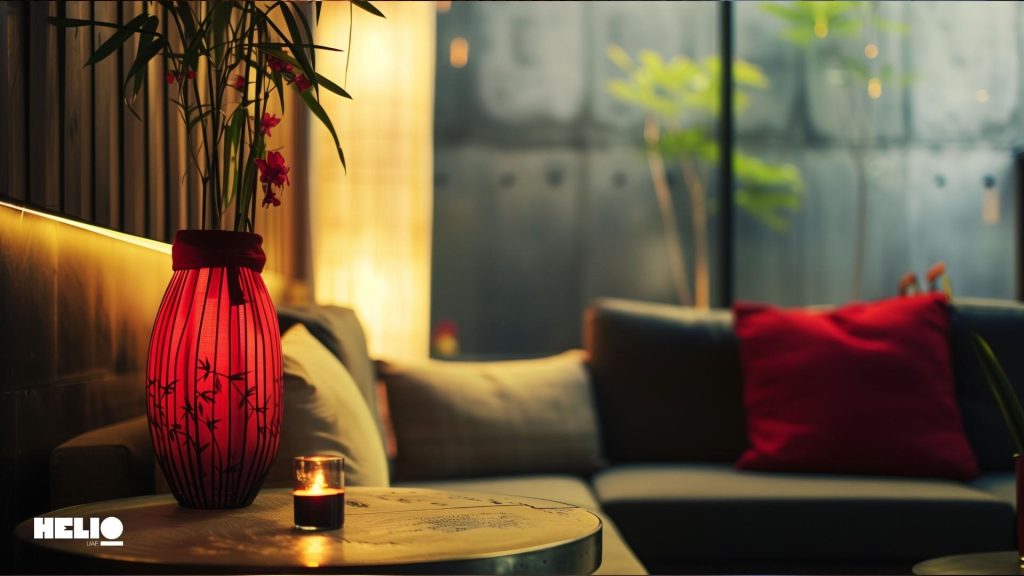
Lighting for Different Living Room Styles
Different living room styles call for different lighting approaches. Here are some ideas:
Modern Living Rooms Lighting Style
Opt for clean lines and simple designs for a sleek and minimalist look. Recessed lighting, slim floor lamps, and geometric pendant lights work well in modern settings. Consider using furniture with streamlined shapes and smooth surfaces to enhance the aesthetic further. To maintain a contemporary feel, incorporate neutral tones like white, beige, and gray, complemented by metallic finishes such as chrome, stainless steel, or brushed nickel. Additionally, strategically placed mirrors amplify natural light, making the space more open and airy.
Accessories should be minimal but thoughtfully chosen to add subtle pops of color or texture without overwhelming the design.
Traditional Living Rooms
Traditional living rooms benefit from classic fixtures with warm tones, creating an inviting and cozy atmosphere. Chandeliers, with their cascading crystals and intricate designs, provide a stunning focal point. Ornate sconces, often adorned with decorative elements, add sophistication to the walls. Table lamps with fabric shades emit a soft, ambient light, perfect for evening relaxation.
Choose fixtures with intricate details and rich finishes like brass or bronze to elevate the room’s elegance. This ensures a timeless and refined look that complements your traditional decor.
Bohemian Living Rooms
Bohemian living rooms are eclectic and colorful; the lighting should reflect this vibrant vibe. Mix and match styles to add variety and interest. Use string lights for a whimsical touch, draping them around windows, doorways, or even across the ceiling. Incorporate colorful lanterns, which can be hung from the ceiling or placed on shelves for a charming effect.
You can also use candles in unique holders to add warmth and a soft glow. The goal is to create a relaxed and artistic atmosphere where each lighting element contributes to the overall boho aesthetic.
Industrial Living Rooms
Industrial living rooms feature raw and functional designs, often characterized by a blend of rugged and refined elements. Exposed bulbs, metal fixtures, and factory-inspired lighting elements are vital components that define this style.
Consider using pendant lights with Edison bulbs to create a warm and inviting glow, and incorporate metal sconces to enhance the industrial look. Reclaimed wood, concrete, and distressed leather can add texture and depth to the space, further emphasizing the industrial aesthetic.
Remember to mix some vintage or antique pieces to give the room a touch of history and character.
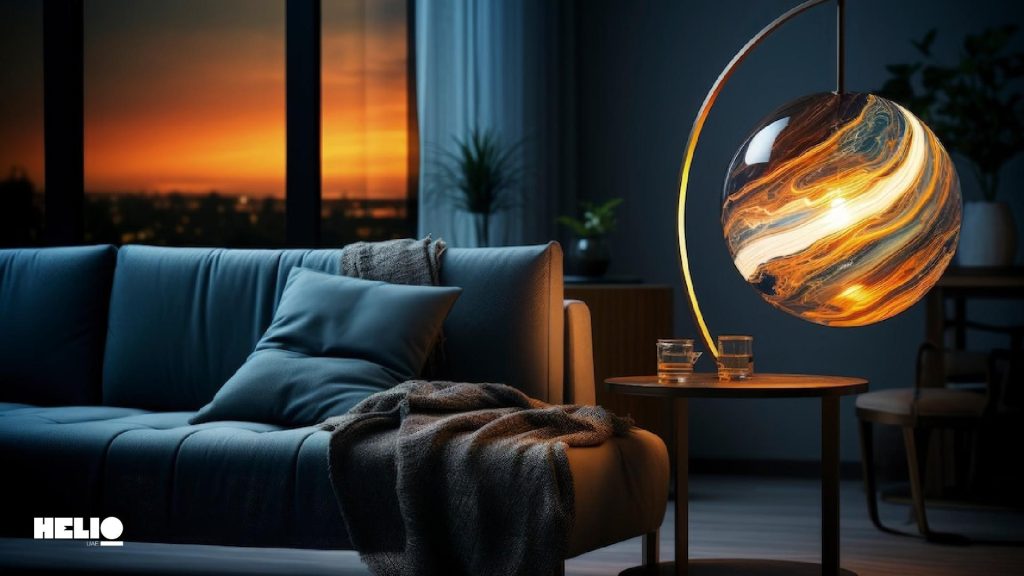
Practical Tips and Mood Lighting Ideas for the Living Room
Implementing mood lighting effectively requires some practical know-how. It involves understanding the proper placement of lights, choosing appropriate color temperatures, and selecting fixtures that complement your space. By considering these factors, you can create an ambiance that enhances your environment’s overall atmosphere and comfort.
Energy-Efficient Lighting
Switching to energy-efficient lighting options like LEDs and smart bulbs can save you money in the long run. These modern alternatives consume significantly less power, reduce electricity bills, and boast a much longer lifespan than traditional incandescent bulbs. Additionally, LEDs are available in various colors and brightness levels, allowing you to customize your lighting to suit any mood or setting.
Smart bulbs offer even more convenience. They enable you to control your lights remotely through your smartphone or voice assistants, enhancing both energy efficiency and home automation.
Choosing the Right Bulbs
Understanding lumens, wattage, and color temperature is crucial for selecting the right bulbs for your home or office. Lumens measure brightness, helping you determine how much light a bulb will produce.
Wattage indicates energy consumption, providing insight into how efficient the bulb is and its impact on your electricity bill. Color temperature affects the mood and ambiance of a space, with warmer temperatures creating a cozy atmosphere and cooler temperatures fostering a more energetic environment.
By carefully considering these factors, you can choose bulbs that not only meet your lighting needs but also enhance your space’s overall aesthetic and functionality. Choose bulbs that align with your lighting goals to create the perfect environment.
Positioning Lights for Maximum Effect
Strategic lighting placement ensures optimal ambiance in any room. Place floor lamps in dark corners to brighten up neglected spaces and give the room depth. Use sconces to frame focal points such as artwork, mirrors, or architectural features to enhance their visual appeal. Place lamps on side tables, consoles, or dressers at different heights to create a balanced look and add light layers.
Experiment with different arrangements, bulb types, and lampshades to achieve the desired effect: a warm, cozy atmosphere or a bright, refreshing space.
Remember to consider the color temperature of the lights, as this can significantly impact the room’s mood and functionality.
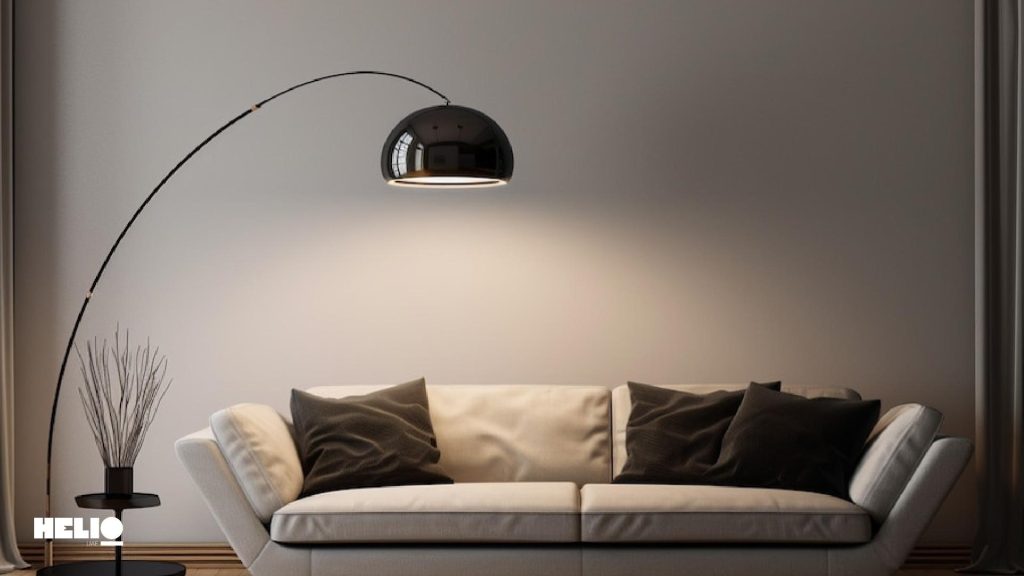
Inspirational Ideas from Experts
Gain insights and inspiration from experts in the field.
Lighting designers offer valuable advice on creating the perfect lighting setup. They emphasize the importance of layering, controlling light levels, and selecting fixtures that complement your decor.
Stay updated on the latest trends in living room lighting. Current trends include smart lighting, eco-friendly options, and incorporating natural materials like wood and rattan into lighting fixtures.
Get creative with DIY lighting projects to personalize your living room. Consider making your pendant lights, customizing lamp shades, or creating a unique light fixture using repurposed materials. DIY projects add a personal touch and a sense of accomplishment.
Conclusion
Mood lighting is a powerful tool that can transform your living room into a warm and inviting space. By understanding the different types of lighting, choosing the right fixtures, and strategically placing them, you can create the perfect ambiance for any occasion. Experiment with other ideas, and feel free to mix and match styles to find what works best for your home.
Ready to elevate your living room lighting? Explore our wide range of options and seek expert advice from our team at Helio Archi. Illuminate your living space with style and sophistication.





